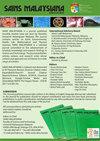餐厨垃圾堆肥分离芽孢杆菌防治水稻病害的潜力
IF 0.7
4区 综合性期刊
Q3 MULTIDISCIPLINARY SCIENCES
引用次数: 0
摘要
细菌性叶枯病、白僵菌病和稻瘟病是分别由水稻黄单胞菌、藤黑镰刀菌和稻瘟病引起的严重的经济危害水稻病害。芽孢杆菌作为一种具有生物活性的环保药剂已被广泛应用于防治这些疾病。本研究从食物垃圾堆肥中分离到5株拮抗菌,分别为枯草芽孢杆菌BS、解淀粉芽孢杆菌C2-1、龙舌兰芽孢杆菌1-BA、地衣芽孢杆菌2-BA和溶血芽孢杆菌。sp菌株3-BA对植物病害的防治效果进行了试验。采用纸盘扩散法检测其对米曲弧菌的抑制作用,采用双重培养法检测其对富士黑弧菌和米曲弧菌的抑制作用。发现解淀粉芽孢杆菌菌株C2-1具有最宽的透明带。在24 h、48 h、72 h和7 d时,菌株对稻瘟病病菌的抑制区分别为7.41±0.65、7.9±0.20、8.8±0.65和8.90±0.12 mm。解淀粉酵母菌C2-1也能抑制水稻真菌病原菌fujikuroi F.和M. oryzae的生长,分别达到98.79%和97.74%。解淀粉芽孢杆菌C2-1菌株在温室中对X.米霉菌、fujikuroi F.和M.米霉菌也有较好的抑菌效果。喷施解淀粉芽孢杆菌C2-1菌株14 d后,水稻x线霉菌、fujikuroi f和M. oryzae的感染分别被抑制了60%、37%和25%。结果表明,解淀粉芽孢杆菌C2-1菌株可作为防治细菌性叶枯病、白僵病和稻瘟病的生物防治剂。本文章由计算机程序翻译,如有差异,请以英文原文为准。
Potential of Bacillus spp. Isolated from Food Waste Compost for Controlling Rice Diseases
Bacterial leaf blight, bakanae and blast are severe, economically damaging rice diseases caused by Xanthomonas oryzae, Fusarium fujikuroi, and Magnaporthe oryzae, respectively. Bacillus spp. have been applied as bioactive, eco-friendly agents to control these diseases. In this study, five antagonistic strains isolated from food waste compost, namely B. subtilis strain BS, B. amyloliquefacien strain C2-1, B. tequilensis strain 1-BA, B. licheniformis strain 2-BA, and Lysinibacillus. sp strain 3-BA were tested for their efficacy againstrice diseases. The inhibition of X. oryzae was tested by paper disc diffusion, while the inhibitions of F. fujikuroi and M. oryzae were tested in dual cultures. It was found that B. amyloliquefacien strain C2-1 gave the widest clear zones. At 24 h, 48 h, 72 h and 7 days, the strain had produced zones of inhibition against X. oryzaeof 7.41±0.65, 7.9±0.20, 8.8±0.65 and 8.90±0.12 mm, respectively. B. amyloliquefacien strain C2-1 also reduced the growth of the fungal rice pathogens F. fujikuroi and M. oryzae, achieving 98.79% and 97.74% inhibitions, respectively. B. amyloliquefaciens strain C2-1 was also effective against X. oryzae, F. fujikuroi, and M. oryzae in the greenhouse. Fourteen days after spraying rice plants with the B. amyloliquefacien strain C2-1, infections with X. oryzae, F. fujikuroi, and M. oryzae were inhibited by 60%, 37%, and 25%, respectively. The results suggested that B. amyloliquefacien strain C2-1 can be used as a biocontrol agent against bacterial leaf blight, bakanae, and rice blast diseases.
求助全文
通过发布文献求助,成功后即可免费获取论文全文。
去求助
来源期刊

Sains Malaysiana
MULTIDISCIPLINARY SCIENCES-
CiteScore
1.60
自引率
12.50%
发文量
196
审稿时长
3-6 weeks
期刊介绍:
Sains Malaysiana is a refereed journal committed to the advancement of scholarly knowledge and research findings of the several branches of science and technology. It contains articles on Earth Sciences, Health Sciences, Life Sciences, Mathematical Sciences and Physical Sciences. The journal publishes articles, reviews, and research notes whose content and approach are of interest to a wide range of scholars. Sains Malaysiana is published by the UKM Press an its autonomous Editorial Board are drawn from the Faculty of Science and Technology, Universiti Kebangsaan Malaysia. In addition, distinguished scholars from local and foreign universities are appointed to serve as advisory board members and referees.
 求助内容:
求助内容: 应助结果提醒方式:
应助结果提醒方式:


